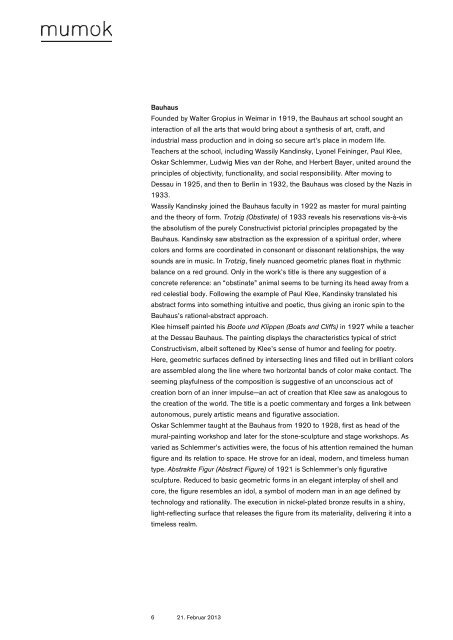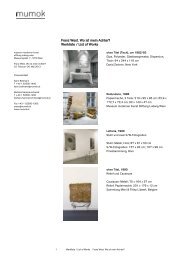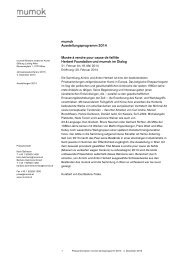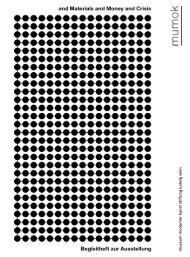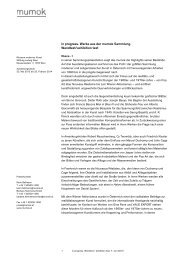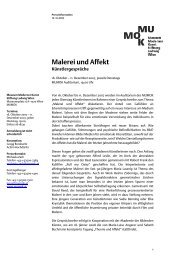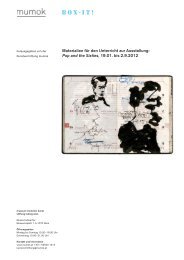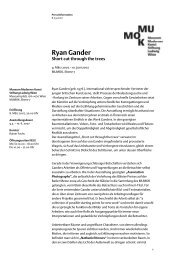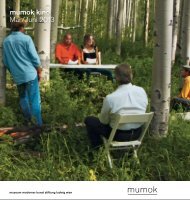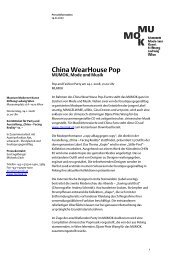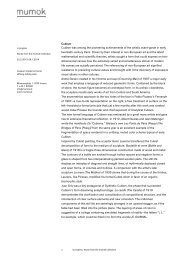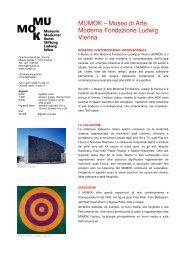in progress. Werke aus der mumok Sammlung Wandtext/exhibition text
in progress. Werke aus der mumok Sammlung Wandtext/exhibition text
in progress. Werke aus der mumok Sammlung Wandtext/exhibition text
Sie wollen auch ein ePaper? Erhöhen Sie die Reichweite Ihrer Titel.
YUMPU macht aus Druck-PDFs automatisch weboptimierte ePaper, die Google liebt.
Bauh<strong>aus</strong><br />
Founded by Walter Gropius <strong>in</strong> Weimar <strong>in</strong> 1919, the Bauh<strong>aus</strong> art school sought an<br />
<strong>in</strong>teraction of all the arts that would br<strong>in</strong>g about a synthesis of art, craft, and<br />
<strong>in</strong>dustrial mass production and <strong>in</strong> do<strong>in</strong>g so secure art’s place <strong>in</strong> mo<strong>der</strong>n life.<br />
Teachers at the school, <strong>in</strong>clud<strong>in</strong>g Wassily Kand<strong>in</strong>sky, Lyonel Fe<strong>in</strong><strong>in</strong>ger, Paul Klee,<br />
Oskar Schlemmer, Ludwig Mies van <strong>der</strong> Rohe, and Herbert Bayer, united around the<br />
pr<strong>in</strong>ciples of objectivity, functionality, and social responsibility. After mov<strong>in</strong>g to<br />
Dessau <strong>in</strong> 1925, and then to Berl<strong>in</strong> <strong>in</strong> 1932, the Bauh<strong>aus</strong> was closed by the Nazis <strong>in</strong><br />
1933.<br />
Wassily Kand<strong>in</strong>sky jo<strong>in</strong>ed the Bauh<strong>aus</strong> faculty <strong>in</strong> 1922 as master for mural pa<strong>in</strong>t<strong>in</strong>g<br />
and the theory of form. Trotzig (Obst<strong>in</strong>ate) of 1933 reveals his reservations vis-à-vis<br />
the absolutism of the purely Constructivist pictorial pr<strong>in</strong>ciples propagated by the<br />
Bauh<strong>aus</strong>. Kand<strong>in</strong>sky saw abstraction as the expression of a spiritual or<strong>der</strong>, where<br />
colors and forms are coord<strong>in</strong>ated <strong>in</strong> consonant or dissonant relationships, the way<br />
sounds are <strong>in</strong> music. In Trotzig, f<strong>in</strong>ely nuanced geometric planes float <strong>in</strong> rhythmic<br />
balance on a red ground. Only <strong>in</strong> the work’s title is there any suggestion of a<br />
concrete reference: an “obst<strong>in</strong>ate” animal seems to be turn<strong>in</strong>g its head away from a<br />
red celestial body. Follow<strong>in</strong>g the example of Paul Klee, Kand<strong>in</strong>sky translated his<br />
abstract forms <strong>in</strong>to someth<strong>in</strong>g <strong>in</strong>tuitive and poetic, thus giv<strong>in</strong>g an ironic sp<strong>in</strong> to the<br />
Bauh<strong>aus</strong>’s rational-abstract approach.<br />
Klee himself pa<strong>in</strong>ted his Boote und Klippen (Boats and Cliffs) <strong>in</strong> 1927 while a teacher<br />
at the Dessau Bauh<strong>aus</strong>. The pa<strong>in</strong>t<strong>in</strong>g displays the characteristics typical of strict<br />
Constructivism, albeit softened by Klee’s sense of humor and feel<strong>in</strong>g for poetry.<br />
Here, geometric surfaces def<strong>in</strong>ed by <strong>in</strong>tersect<strong>in</strong>g l<strong>in</strong>es and filled out <strong>in</strong> brilliant colors<br />
are assembled along the l<strong>in</strong>e where two horizontal bands of color make contact. The<br />
seem<strong>in</strong>g playfulness of the composition is suggestive of an unconscious act of<br />
creation born of an <strong>in</strong>ner impulse—an act of creation that Klee saw as analogous to<br />
the creation of the world. The title is a poetic commentary and forges a l<strong>in</strong>k between<br />
autonomous, purely artistic means and figurative association.<br />
Oskar Schlemmer taught at the Bauh<strong>aus</strong> from 1920 to 1928, first as head of the<br />
mural-pa<strong>in</strong>t<strong>in</strong>g workshop and later for the stone-sculpture and stage workshops. As<br />
varied as Schlemmer’s activities were, the focus of his attention rema<strong>in</strong>ed the human<br />
figure and its relation to space. He strove for an ideal, mo<strong>der</strong>n, and timeless human<br />
type. Abstrakte Figur (Abstract Figure) of 1921 is Schlemmer’s only figurative<br />
sculpture. Reduced to basic geometric forms <strong>in</strong> an elegant <strong>in</strong>terplay of shell and<br />
core, the figure resembles an idol, a symbol of mo<strong>der</strong>n man <strong>in</strong> an age def<strong>in</strong>ed by<br />
technology and rationality. The execution <strong>in</strong> nickel-plated bronze results <strong>in</strong> a sh<strong>in</strong>y,<br />
light-reflect<strong>in</strong>g surface that releases the figure from its materiality, deliver<strong>in</strong>g it <strong>in</strong>to a<br />
timeless realm.<br />
6 21. Februar 2013


